Welcome to my book page…
…Here you’ll find the various books I’ve written over the years, with my comments and anecdotes about them.
The majority, even those no longer in print in a paper edition, are still available as ebooks for the ereader of your choice. Clicking on the appropriate links in each description will take you to the print or ebook publishers. Enjoy browsing!
The Night Listener and Others
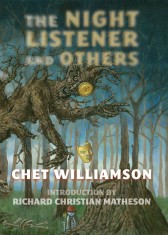 The Night Listener and Others, my second collection of short stories and novellas, was published in May 2015 by the UK’s PS Publishing. Peter Crowther and his staff did a beautiful job with this limited edition hardcover, with a wraparound dustjacket by Jill Bauman, an introduction by Richard Christian Matheson, and 22 stories, none of which were in my earlier collection. At the back of the book are my own notes and comments on each story. The book is available in a boxed, signed, and numbered edition, as well as a standard hardcover. I can’t resist quoting from RC’s introduction: “For those privileged few, lucky enough to be new to the miraculous Chet Williamson, you are about to enter worlds of glorious and sinister wonder. I envy you.”
The Night Listener and Others, my second collection of short stories and novellas, was published in May 2015 by the UK’s PS Publishing. Peter Crowther and his staff did a beautiful job with this limited edition hardcover, with a wraparound dustjacket by Jill Bauman, an introduction by Richard Christian Matheson, and 22 stories, none of which were in my earlier collection. At the back of the book are my own notes and comments on each story. The book is available in a boxed, signed, and numbered edition, as well as a standard hardcover. I can’t resist quoting from RC’s introduction: “For those privileged few, lucky enough to be new to the miraculous Chet Williamson, you are about to enter worlds of glorious and sinister wonder. I envy you.”
Andrew Vachss Underground
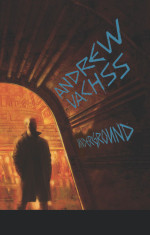 I scripted and helped to edit a lengthy graphic novel based on an unpublished screenplay by Andrew Vachss for Dark Horse Comics. Mike Richardson scripted the first 24 pages, which appeared serially in DARK HORSE PRESENTS, and I wrote the remainder of the 144 page book, Andrew Vachss Underground, a gorgeous hardcover with art by Dominic Reardon.
I scripted and helped to edit a lengthy graphic novel based on an unpublished screenplay by Andrew Vachss for Dark Horse Comics. Mike Richardson scripted the first 24 pages, which appeared serially in DARK HORSE PRESENTS, and I wrote the remainder of the 144 page book, Andrew Vachss Underground, a gorgeous hardcover with art by Dominic Reardon.
Though there are similarities between this graphic novel and a four-issue run of UNDERGROUND back in the mid-90s, this is an all new creation and story, and I was delighted to be a part of it.
Hunters
 Hunters is the second of my ebook originals from Crossroad Press. Another dark suspense novel with elements of horror, it’s set in the woods of my own native Pennsylvania. A group of animal rights activists wants to make a bold statement against deer hunting on the first day of the season, but the statement gets a bit too bold — and bloody…
Hunters is the second of my ebook originals from Crossroad Press. Another dark suspense novel with elements of horror, it’s set in the woods of my own native Pennsylvania. A group of animal rights activists wants to make a bold statement against deer hunting on the first day of the season, but the statement gets a bit too bold — and bloody…
Defenders of the Faith
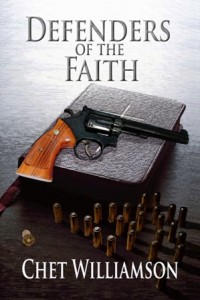 Defenders of the Faith is my first novel that was an ebook original from Crossroad Press, though the trade paperback followed shortly thereafter. It’s a horror novel crossed with a suspense thriller, and there’s no supernatural element.
Defenders of the Faith is my first novel that was an ebook original from Crossroad Press, though the trade paperback followed shortly thereafter. It’s a horror novel crossed with a suspense thriller, and there’s no supernatural element.
The book is an exploration into what happens when one’s religious faith comes up against one’s reason. It’s told from the point of view of a basically good man who crosses the threshold of violence, and discovers that he has inspired a young and even more crazed disciple.
Fearnet said: “This isn’t a simple tale. It is full of contradictions, in the way that life is full of contradictions. There is no distinct line between good and bad and right and wrong. As a study of a truly tragic character, Defenders of the Faith is one of modern horror’s best examples.”
Horror Drive-In added: “Chet Williamson is a complicated writer and Defenders of the Faith is a complicated novel. I’m not saying that it’s stodgy or overly intellectual. This is a lightning-paced thriller. It’s just that Chet doesn’t present right and wrong in clearly defined terms. You won’t find the good guys wearing white hats and the bad guys with black ones on their heads…Defenders of the Faith is a book for the ages.”
The Story of Noichi the Blind
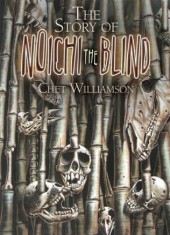
- The Story of Noichi the Blind (Cemetery Dance Publications, 2007)
The novella is my favorite length in which to write horror, so when Richard Chizmar requested a novella for Cemetery Dance’s hardcover novella series, I immediately started thinking about what to write.
My son Colin moved to Japan when he was still in college, transferring to Temple’s Tokyo campus and then staying there after graduation, working first for Anchor and then for Square Enix as a videogame designer. My fondness for all things Japanese has increased during his tenure there and our many visits. And one of the things I have long liked about Japan has been the writer Lafcadio Hearn. So I decided to create a “rediscovered” Hearn story which I would then “edit” with the help of the fictitious Alan Drew, Ph.D., a Hearn scholar.
The result was The Story of Noichi the Blind, complete with an introduction telling how my son found the story and sent it to me, and how the manuscript’s typeface was identified by the very real Richard Polt, who is an expert in antique typewriters and also runs theHarry Stephen Keeler website. The story follows, and the volume ends with an Afterword by Dr. Drew in which, through textual analysis, he concludes that the tale is not by Hearn, but by an unknown admirer living in Japan sometime before 1940.
The whole creation was a delight to concoct, and the story itself is one of the most disgusting things I’ve ever set to paper, though told in a classic, fairytale manner that somehow makes it palatable. The reviewers seemed to have as much fun with it as I did, and my favorite comment was one from the Booklist reviewer who said, “This extraordinary performance makes such comparably transgressive writing as the Marquis de Sade’s seem totally crude.” Now that made my year.
The delightful cover painting is by the wonderful Jill Bauman (I own the framed initial monochromatic study she did for it). I have also turned the story into a play for puppet theatre, blending traditional Japanese puppetry with contemporary puppetry, in the hopes that somewhere, someday, someone will be twisted enough to undertake the project…
Pennsylvania Dutch Alphabet
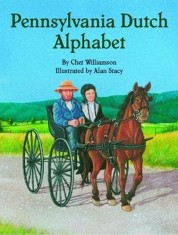
Another picture book, this follow-up to myPennsylvania Dutch Night Before Christmas has a four-line poem about the Pennsylvania Dutch for each letter of the alphabet, along with some explanatory text. Among the more predictable ones are “Quilt,” “Corn,” “Shoo-fly Pie,” and “Pretzels,” but I was stumped for “X” until my now deceased Pennsylvania Dutch friend, Lloyd Arthur Eshbach(founder of Fantasy Press and a science fiction pulp writer since 1929) suggested “X” as in: “The chicken lays the X.”
So I came up with “X is for eggs –/That’s how you pronounce them:/’Bring in the ecks!/Be sure not to bounce them!’”
The illustrations, much more faithful to the Pennsylvania Dutch culture, are by Alan Stacy, and the book is available from Pelican Publishing.
Figures in Rain
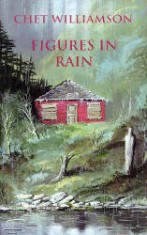
- Figures in Rain (Ash-tree Press, 2002)
If I had to take along one book of mine with which to be stuck on a desert island, it would be this collection of many of my short stories. I had been a collector of Ash-tree Press volumes, since they specialize in classic ghost stories, and I’ve long been a fan of such tales in the vein of M. R. James, E. G. Swain, and others. So when they approached me to do a collection of my own supernatural tales, I leapt at the chance.
I arranged the volume in chronological order, with my very first story from a 1981 issue of Twilight Zone Magazineleading the way. I wrote detailed notes on every story, which were placed in the rear of the hefty volume (27 stories & over 300 pages of quite small print), and Joe Lansdale penned an introduction which still makes me blush whenever I read it. Three times a day. “He’s earned the right to be recognized as one of the finest writers of our generation. And generations beyond, I’m sure.” I love that Joe…
Others seemed to agree, since the reviews were fairly incandescent. The book was shortlisted for the World Fantasy Award, and won the International Horror Guild Award, while one of the two new stories I wrote for the book was nominated for the IHG Award as well. The book is still available from Ash-tree, and is also available at Amazon right here…
Uniting Work and Spirit: A Centennial History of Elizabethtown College
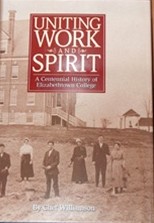
This is the first and only college history I have ever written or will ever write. I was commissioned to write the centennial history of Elizabethtown College, a small liberal arts college founded by the Church of the Brethren in my town. I’d never written a non-fiction book before, but someone at the college thought that a writer like me would produce a much more readable and engaging book than most dry-as-dust historians would turn out. I like to think they were right.
I wrote the history about the people who built and nurtured the college, and not the college itself, and it was a much more fascinating journey than I had thought. Though I was offered research assistants, I chose to do all the research myself, and went through every issue of the college newspaper, every yearbook, endless piles of college catalogues and more. I dug into the archives, uncovering some scandalous stories about the college founders, and showing that J. G. Francis, considered the George Washington of the school, was in fact a petty, vindictive man who ultimately tried to destroy the school because he felt as though he had been under-appreciated by those who took control.
Unfortunately, I spent an entire year researching and writing the history, a year that, as it turned out, could have been more wisely spent, at least in financial terms. If you’re interested in having me write a history of your college, my price will start in the mid-six figures.
Only real completists would want this book, available in hardcover and paperback. But if you do, the E-town College Bookstore has it…
Pennsylvania Dutch Night Before Christmas
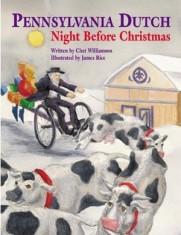
- Pennsylvania Dutch Night Before Christmas (Pelican Press, 2000)
Those readers who know me from my work in suspense and dark fantasy may well wonder whatthis strange creature is. What it is, friends, is my best selling book to date.
For many years I’ve written my wife Laurie a short story every Christmas. (My friend Charles de Lintdoes the same for his wife, and I suspect we’re not the only ones.) Lancaster County, where we live, contains a lot of Pennsylvania Dutch folks, and my grandparents all spoke with that curious dialect (my grandfather Hershey actually wrote poetry in that regional language), and my rendition is pretty good.
When my son Colin was small, we of course readThe Night Before Christmas to him, and found The Cajun Night Before Christmas, which became a tradition as well. One Christmas Laurie told me that I should write a Pennsylvania Dutch version, so I did that instead of a story. It proved such a hit that she insisted I send it to Pelican Press, which printed a number of these Night Before Christmas parodies in hardcover. So I did, along with a cover letter praising the area as a tourist trap in which such a book would sell mightily, and they bought both the argument and the book. The late James Rice did the illustrations, but being a Texan he didn’t quite grasp such regional niceties as hex signs and Amish quilts, and even though I provided a lot of reference photos, there are still a few errors in the art (check out those horns on my Holsteins!). Nevertheless, the book was and continues to be a huge regional success. At one Borders pre-Christmas signing alone we sold 800 books, and the line stretched out of the store. The book is in its sixth printing, and sells year after year, along with the coloring book and the recording that I made (complete with sound effects). Check outPelican Publishing for the whole “product line” and an old photo and bio. I’ll be putting up an excerpt from the book on the website soon…
The Searchers: City of Iron
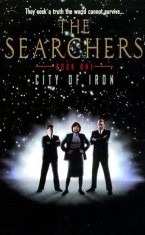
This is the first volume of a three-book series of paperback originals I wrote for Avon Books. An editor at Avon approached my then-agent with an idea of a trilogy about paranormal investigators, since both The X-Filesand Men In Black were huge at the time, and my agent suggested me to write it. After passing the audition, so to speak, I got the job.
The good part was that it wasn’t work-for-hire. I would be the owner of the rights. Since I’d decided to stop doing work-for-hire, this seemed an intriguing way to get back into writing my own novels. Both the editor and I felt that the books should stay as far away from X-Files territory as possible, which would be easy for me. Though I often watched the show, I wasn’t obsessive about it. I decided to spice up the mix with a good dose of skepticism about the paranormal, and gave my secret team of government investigators the job of debunking supposed supernatural occurrences. In the notes at the back of every volume, I suggested that readers crack the covers of such skeptical classics as Gordon Stein’s The Encyclopedia of the Paranormal, The Demon-Haunted World by Carl Sagan, and other books by James Randi, Martin Gardner, and Michael Shermer. I also gave them CSICOP’s web address.
The story concerned an ageless being, possibly an alien, who was being guarded by the Catholic Church. The Knights Templar played a large part in the series (this was beforeThe DaVinci Code), and the three investigators, Laika Harris, Tony Luciano, and Joseph Stein start in New York City to investigate “a conspiracy that could shatter every belief about the origin of man…and God,” as the cover copy put it.
Though I’d thought Shadow Ops an evocative title for the series, the marketing department at Avon came up with The Searchers. Though I protested that there was no sign of John Wayne nor Native Americans in the book, The Searchers it became.
The editor and I agreed that the covers should be very contemporary and edgy, but again, the marketing department had different ideas. Since they wanted the books to appeal to the X-Files and Men In Black fans, what more brilliant method than making the covers look like an actual morph of those two franchises, with the three agents striking poses in front of a star field? And did it work? Well, Locus said, “The cover art and design package seem intended to attract fans of Men in Black and The X-Files. City of Iron is not a novelization of an existing film or TV show; but it does seem clearly aimed at suggesting a literary equivalent.” Science Fiction Chronicle opined, “…pretty obviously packaged to look similar to X-Files, but which contains a much better story.” Many readers (and Amazon reviewers) said that they almost didn’t pick up the book because it looked like an X-Files ripoff. And it did. It most certainly did. And so it goes.
Nevertheless, what reviews there were, were good and readers liked it. You might too. Contact me if you’d like copies — always happy to sign them for readers…
…and the ebook is available here at Amazon.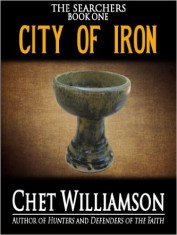
The Searchers: Empire of Dust
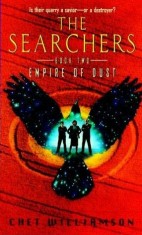
The Searchers: Empire of Dust (Avon Books, 1998)
Empire of Dust was the second book in The Searchersseries. I decided to set it in an location with which I’ve always been fascinated, the High Desert of the Southwest: Arizona, New Mexico, that whole Four Corners area. Apparently the marketing department saw the chance to tie in The Crow and crop circles as well on the cover. Sigh…
I dedicated this one to my ole pard, Joe R. Lansdale.. It wasn’t set in his home town of Nacogdoches, Texas, but it was close. Sorta. You can buy the ebook here at Amazon.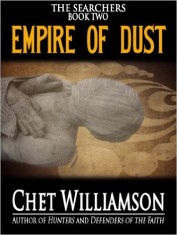
The Searchers: Siege of Stone
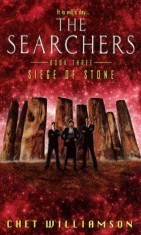
- The Searchers: Siege of Stone (Avon Books, 1999)
The third volume in The Searchers series took place in Scotland, where I’d vacationed several years earlier. I tried to leave the final volume slightly open-ended in case the publisher wanted me to continue the series. No such luck. Each subsequent volume sold less than the one before, partly due to the fact that the publisher made the print run smaller with each volume, thus creating the self-fulfilling prophecy they’d begun with the marketing department’s decision to make the covers appear as derivative as possible.
An interesting footnote: a year or so after this final volume came out I sold a book on eBay to Timothy Binga for the CSICOP (The Committee for Skeptical Inquiry) library. When I sent the book, I also sent a set of the trilogy, with a letter explaining what my purpose had been with the books, to actually further CSICOP’s cause by urging readers to become more skeptical about the paranormal. Binga actually reviewed the books on CSICOP’s website, and was very complimentary about them and my effort to bring a bit of enlightenment to readers.
And again, you may buy the ebook at Amazon.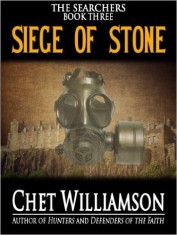
The Crow: Clash by Night
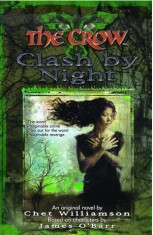
- The Crow: Clash by Night (HarperPrism, 1998)
A year after I wrote The Crow: City of Angels, I was asked to write an original novel using the concept of James O’Barr’s The Crow. Though I was wearying of writing work-for-hire material, I agreed. I was simpaticotoward the concept, which gave me total freedom in terms of characters and setting, something that nearly all other licensed properties did not.
Clash by Night, which appeared as a large trade paperback, explored the right-wing militia underbelly of the United States while using a female lead character and telling a tragic love story, and I was pleased with the result. For better or worse, it turned out to be a Chet Williamson novel. Ed Bryant said in Locus: “The passion in Clash by Night is furnace-hot, of a degree that is virtually Biblical…Chet Williamson knows what he’s doing…the heart is engaged. Lock and load, readers — and keep that box of tissues handy. With its risky juggling of passion and politics, indignation and melodrama, longing and loss, Clash by Night stands perfectly well on its own. And it doesn’t matter if you don’t know the Crow from the Owl and the Pussycat, or a Raven from a Writing Desk.”
The novel was collected, along with original Crow novels by David Bischoff and Poppy Z. Brite, in the hardcover anthology, The Crow: A Murder of Crows.
I said goodbye to The Crow with a short story published in The Crow: Shattered Lives and Broken Dreams. It was called “The Blood-Red Sea,” a pacifistic Crow tale in which the protagonist, the ancient poet Homer, ultimately decides not to use violence against those who wronged him. It’s in my short story collection, Figures in Rain.
The Crow: City of Angels
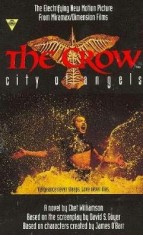
The Crow: City of Angels was the sequel to the original blockbuster starring Brandon Lee. This time around, Vincent Perez was the murder victim who returns from the dead to “make the wrong things right,” which basically consists of killing everyone who had anything to do with his death and, in this go-round, the death of his child as well. I was contracted to write a novelization of David S. Goyer’s screenplay, which was a powerful and moving piece of work. Unfortunately the film itself left most of the good stuff on the cutting room floor, if it was ever filmed at all.
I had only three weeks in which to write the novel, but for some reason I was possessed by the material and the themes of love and loss which are so much a part of my own original work, so much so that I finished the book in a white-hot two weeks, embellishing and expanding on Goyer’s fine work, filling out the backstory of the various characters, and just having a helluva lot of fun.
I used epigrams for all 24 chapters, including many quotations from James Thomson’s epic poem, “The City of Dreadful Night,” and many more from classical literature about crows. In the short time I had I put an enormous amount of energy and thought into the novel, and was hugely disappointed when I saw the film the night it opened across the country. The novel, though out of print, is available on the Collector’s Series DVD.
Cross
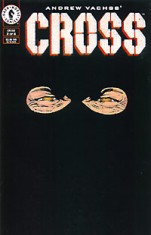
Andrew Vachss’ Cross was a six-issue graphic novel that I scripted from Andrew’s and Jim Colbert’s story of the same name. Geoffrey Darrow did the extraordinary covers. It was an intense and raw story about a group of mercenaries working together in the jungle of the city, and I hope my script did it justice. I also adapted another Vachss story for Dark Horse’s Hard Looks.
My friendship with Andrew Vachss has been one of the highlights of my writing life. I consider him a brilliant, fire-breathing writer, and his lifelong concern with children’s rights makes him one of the last true American heroes. I strongly encourage everyone to join Protect: National Organization to Protect Children. And visit Andrew’s website, The Zero – you’ll find it a fascinating journey…
Murder in Cormyr
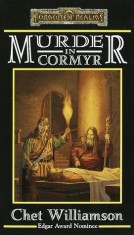
Murder in Cormyr was the second original novel I wrote for TSR, based on their fantasy gaming world. This was a mystery in which a sedentary wizard does the brainwork while his assistant does the footwork (Nero Wolfe & Archie, anyone?). I used the old gag of supernatural fakery to cover up an all too natural series of murders. It was published in hardcover and a year later in paperback, and the target audience of Forgotten Realms gamers seemed to enjoy it.
I’d never played D&D, so I had to pore through the manuals for research for both this novel and Mordenheim, but never had to shake a pair of 27-sided dice.
The novel is available as an ebook at Amazon.
My only other foray into TSR writing was a short story, “The Vanished Ones,” reprising the character of Ivan Dragonov, a werewolf I wrote about in Mordenheim. The story appeared in 1994’s Tales of Ravenloft.
Hell: A Cyberpunk Thriller
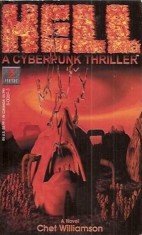
Certainly one of the strangest writing projects I’ve ever done, this was a work-for-hire novel adapted from a computer game, which was pretty hot stuff (no pun intended) at the time, since it was voiced by Dennis Hopper and Grace Jones, among others. The game, which I played through before I started, was goofy fun, and dealt with a near future world in which society is divided along religious lines, and Hell is an actual place to which malefactors are condemned for going against the established religious state. All of it, of course, is virtual, and our heroes are two government agents who get on the bad side of the church and have to bring down the system to save themselves.
It was as nutty a story as it sounds, and I got a lot of help in the cybervein from my son Colin, who, though still in high school, was a staff writer for PC Gamer magazine. I name checked him and a number of his friends in the book, and dedicated it to him as well. The folks at Prima and Take 2, the game company, were a joy to work with, and the book was featured in an article in Entertainment Weekly.
I was contracted to do another novel based on a horror board game called Atmosfear —clever, eh? – that included a videotape (talk about obsolete media…), and was supposed to take the world by storm. It didn’t, and the novel was never written, other than an unpublished 60 page novella. Believe me, it was just as well…
Second Chance (paperback)
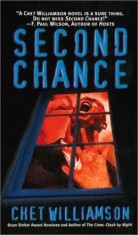
Leisure Books published Second Chance in paperback in 2002 in their horror line, and I was glad to have the novel find a larger audience.
Second Chance
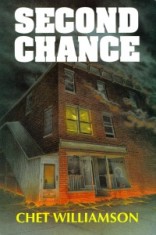 This is probably my favorite novel of those I’ve written so far, as it’s closest to the concerns of my own life. When I’m asked to describe it, I usually refer to it as a ecoterrorist time-travel fantasy thriller romance, which indicates the dangers of genre labeling. Let’s just call it anovel about how the turbulent sixties affected those who grew up during that time. As one reviewer said, “It’s a thriller, it’s a time travel novel, it’s a look at how we romanticize the past, and it’s an examination of how hard it is to stay true to your youthful ideals.” Bingo.
This is probably my favorite novel of those I’ve written so far, as it’s closest to the concerns of my own life. When I’m asked to describe it, I usually refer to it as a ecoterrorist time-travel fantasy thriller romance, which indicates the dangers of genre labeling. Let’s just call it anovel about how the turbulent sixties affected those who grew up during that time. As one reviewer said, “It’s a thriller, it’s a time travel novel, it’s a look at how we romanticize the past, and it’s an examination of how hard it is to stay true to your youthful ideals.” Bingo.
Charles De Lint in The Magazine of Fantasy & Science Fiction called it “a hard speculative exploration of the impact those incendiary times had upon some of us who lived through them,” while Time Tunnel’s T. Liam McDonald said, “it is a piercing look at idealism unhinged, of the world-shattering power of love, hate, and zealous belief…one of the most unusual and moving books in a long time.” And The New York Review of Science Fiction called it “a wonderful and dreadful evocation of the way in which history and politics haunt us all…”
My friend Rick Huck painted the dust jacket cover, and I own the original. It’s a depiction of the building in which I lived in college, with a bookstore on the first floor, just as shown here.
And here’s a link to the ebook at Amazon… 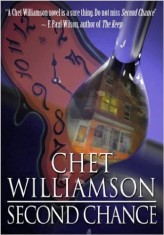
Mordenheim
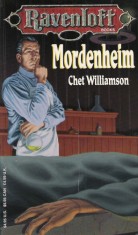
Through editor Brian Thomsen, I was commissioned to do two work-for-hire novels set in the TSR gaming worlds. The first of these was Mordenheim, TSR’s avatar of Frankenstein. I got to create my own plot, set in what was actually a mildly disguised universe of 1930s-40s Universal horror movies, and had a blast doing it. While certainly not the most serious thing I’ve ever written, I took it seriously and did the best job I could while playing in someone else’s world and by their rules.
I’ve always loved the classic horror monsters, and getting to write my own version using these archetypes was like getting a paid vacation…
Aliens: Music of the Spears
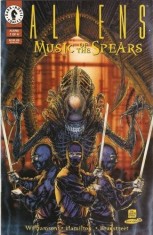
- Aliens: Music of the Spears (Dark Horse, 1994)
In 1994 I landed an assignment to write a 4-issue arc of Dark Horse’s Aliens series, and decided to somehow link the aliens to the arts. Music of the Spears 1-4 was the result. I came up with a plot in which a contemporary composer uses the screams of the aliens in his classical compositions, but is frustrated by not being able to find just the right tones, so he steals a little alien egg and hatches his own. Then the fun really starts.
I took the job very seriously and did layouts with (very) rough sketches for penciller Tim Hamilton. Tim Bradstreet did the inking and the fantastic covers. Yvonne Navarro wrote a novelization of my graphic novel script, and the comics themselves were reprinted (but with only one of the great covers) in Dark Horse’s Aliens Omnibus Volume 4 in 2008.
Thrillers
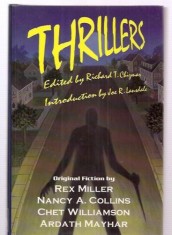
- Thrillers (CD Publications, 1993)
Thrillers was the first of a series in which an editor would choose four authors to write a certain number of words of suspense fiction. Richard Chizmar edited this volume, which I shared with Rex Miller, Nancy A. Collins, and Ardath Mayhar. My contribution was a short story, “Watching the Burning,” and a novella, “Dusty Death.”
I always love the chance to write at novella length, and had a great and twisty time writing about a murder that comes back to haunt the protagonist. The short story was a real quirky, psychological work, more of a character study than a crime story, the crime being one of omission…
Reign
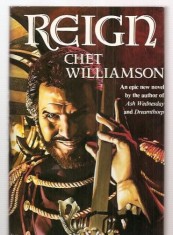
I loved writing Reign, which was published in hardcover by Dark Harvest in several collectors’ editions. It was a novel set in world of the theatre, where I’ve lived a goodly portion of my life. I got into writing as the result of being a professional actor (a long story that I’ll blog about someday), and have, in the past few years, reinstated my Actors Equity card and am trodding the professional boards once again, to my great pleasure.
Reign is the story of an actor based on Yul Brynner, who plays the same stage role for so many years that he becomes identified with it. In my novel, however, the character takes on a life of its own, becoming a malevolent doppelganger. The scenes with “The Emperor” are written in play form, a harbinger, I suppose, of the actual plays I would later write. Reaction was strongly positive. The novel was nominated for a Stoker Award, and Publishers Weekly called it “believable, elegant (and) thoroughly enjoyable,” while Gauntlet said, “honest, uncompromising and emotionally charged in a way that is too uncommon in works of horror fiction.”
John and Laura Lakey did the beautiful wraparound dust jacket and interior illustrations. But that dust jacket proved a bit embarassing when my ole pard Joe R. Lansdale’s blurb was credited to Joe B. Lansdale. 20 years down the road, and I’m still apologizing…
The book has never been published in paperback, and I think it’s damn well about time. It is available in ebook format, however, and you can find it here… 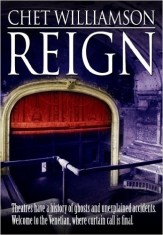
Night Visions 7
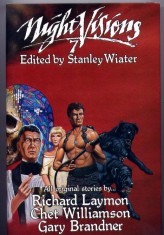
Every volume of the Night Visions series from Dark Harvest allowed a different editor to ask three writers to come up with 30,000 words each. Stan Wiater recruited Dick Laymon, Gary Brandner, and me for the seventh volume. I wrote a novella ( The Confessions of St. James), a short story, “Blue Notes,” and a tiny short-short with a really long title (“Assurances of the Self-Extinction of Man”), so I really spanned word lengths.
The Confessions of St. James, which was nominated for a Stoker Award, was great fun to write, the tale of a cannibalistic clergyman who takes the concept of Holy Communion a bit too seriously. His fictional church was based on Donegal Presbyterian Church near my home. It has a marvelous old cemetery with graves & tombs dating back to the Revolutionary War.
I think the novella is my favorite length of story when I wrote horror. It really allows you to expand ideas and characterization without necessitating subplots and extra characters that can often make novel-length works lose that intense focus which is so imperative to a mood of terror. It’s too bad there are so few markets for that length of tale. The Confessions of St. James has been reprinted in my second collection, The Night Listener and Others.
The House of Fear: A Study in Comparative Religions
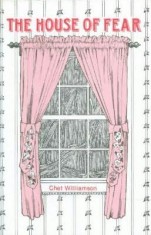
- The House of Fear (Footsteps Press, 1989)
“A Study in Comparative Religions” was the original title of this chapbook, but when publisher Bill Munster suggested that the title might lead readers to think it a piece of non-fiction, I retitled it. It was limited to 500 copies, and contains beautiful interiors by Douglas C. Klauba. My old friend Steve Bissette was going to do the illos, but ran into some scheduling problems, and Doug’s work fitted the story perfectly.
It’s a fairly bizarre allegorical tale about superstitious behavior, and was reprinted in 2002 in my short story collection, Figures in Rain, complete with notes from me explaining the story’s sources, and talking more about it.
Dreamthorp
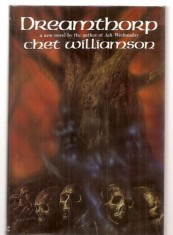
- Dreamthorp (Dark Harvest/Avon, 1889)
Published simultaneously in hardcover (from Dark Harvest) and paperback (from Avon) I’ve chosen to show Bob Eggleton’s terrific dust jacket rather than the well-painted but “horror-novelly” clutching tree-man cover from Avon. Bob did some fine interior illustrations as well.
Dreamthorp’s working title was The Little Houses, and it wasn’t until I finished the first draft that I found the 19th century book of essays, Dreamthorp, that gave the novel its theme and chapter headings. I tended to go a bit overboard on the violence with this one. One reviewer accused me of “excessive pornoviolence,” to which I can only reply, Don’t tell my mom… But most reviews were good, calling the book “a wonderful piece of dark American fantasy” and “a near-perfect novel.”
The village of Dreamthorp is based on Mt. Gretna, an old Chautauqua community just a few miles from my home, and a lovely place to spend a summer day or evening. Really.
The book is available as an ebook at Amazon.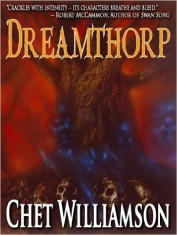
Lowland Rider
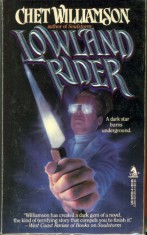
Lowland Rider was published as a paperback original, and was my “New York Subway System” novel. The cover painting has nothing whatsoever to do with the plot, which concerns a man who buries himself beneath New York City after his wife and child are brutally murdered. He becomes aware of a dark supernatural plot brewing that threatens to undo the delicate balance between good and evil in the world. Naturally, hilarity and a lot of bloodshed ensue.
I wrote a faux Scottish ballad that I used in between sections of the novel to comment on the action, and several reviewers believed that it was an actual old ballad…always fun to fool people.
Reviews were good. My favorite was from Fear, which said: “He injects Lowland Rider with a humanity rarely seen in comparable horror novels. Commendably mature, unlike so many authors who sacrifice plot for excessive visceral sensationalism…A highly innovative and original novel (and) the bleakest and most downbeat horror novel of 1988…”
The cover of the British edition was much better than the U.S. edition, since it actually had something to do with subways. The ebook is available at Amazon. 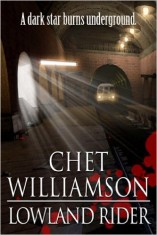
McKain’s Dilemma
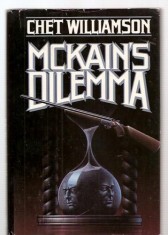
- McKain’s Dilemma (Tor Books, 1988)
My first suspense novel, McKain’s Dilemma, was published in hardcover as part of Tor’s new but quickly aborted mystery line. After the editor left the house, the book was orphaned, and the line quickly vanished. I doubt if 500 copies of the book were sold.
It was a shame, as the book was my attempt at a more realistic mystery novel, with the private eye protagonist being a family man who stumbles into a murder somewhat by accident, and writing the first person narrative for a definite reason. I alternated the first person sections with third person segments dealing with various characters to deal with various points of view. Another plot element of interest was that the private detective was suffering from a terminal illness (which somewhat diminished the possibility of a series). The novel, though it received positive reviews, was never published in paperback, has long been out of print, and is available in the used book market. You’ll have a much easier time finding the ebook here at Amazon…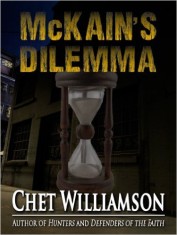
Ash Wednesday
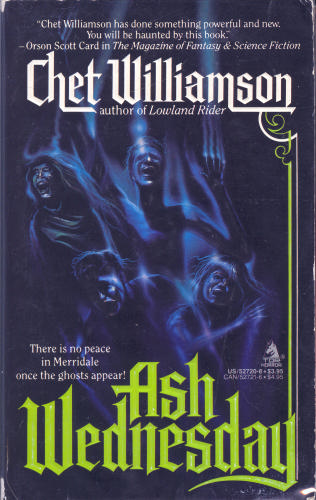
This was my second novel, published by Tor Books in hardcover and then in paperback.
It was an attempt at a “passive” horror novel, in which people in a small town (modeled after my own Elizabethtown) wake up one morning to discover that the dead are now visible as naked, semi-transparent blue forms, in the position that they were at the moment of death. They don’t move, they don’t speak; they are merely grim reminders of mortality. The action of the novel stems purely from the townspeople’s reactions to these ghosts. The plot also bears numerous parallels to Conrad’s Lord Jim.
The book was a final nominee for the 1988 Horror Writers of America’s Stoker Award. InThe Magazine of Fantasy & Science Fiction, Orson Scott Card wrote, “Chet Williamson has done something powerful and new. You will be haunted by this book.” Library Journal: “a fine psychological thriller…and a richly textured and satisfying novel.” Fantasy Review: “a rich, carefully constructed novel about the ravages of guilt and about the real horror of life.” Rave Reviews: “a riveting, descriptive account of the effect the dead have on the living…both thought-provoking and entertaining.”
Fritz Leiber, who was one of my literary idols as I grew up, wrote: “By following the science-fiction precept of examining realistically and carefully the results of a single change in the circumstances of existence, Williamson has built a strong if necessarily macabre and uncomfortable tale of moral import.”
The novel has received a separate entry in the three-volume Supernatural Literature of the World, which declared it imbued “with a poignancy most horror novels only hope to achieve.”
An interesting footnote is that the final chapter was removed by editorial suggestion, and printed for the first time in Issue # 9 of Bill Munster’s magazine, Footsteps, in 1990.
One more item of interest is that the first dust jackets printed were embossed, but the name of the author was misspelled “Chet Willimson” everywhere on the jacket. The corrected jacket bore no embossing. I donated a copy of the book with the first state, never released dust jacket to an HWA auction, where it sold for over $300.
The book is now out of print, but is easily found in the used book markets. As for the first state jacket, not so much. Still, you can grab the ebook here…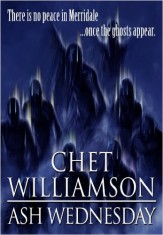
Soulstorm
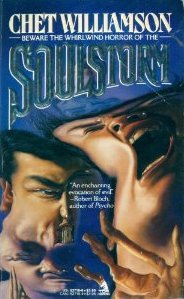
My first novel, a paperback original from Tor. The three pages of maps and floor plans at the front of the book were drawn by my father.
To make the transition from short story writer to novelist, I wanted my first book to have a fairly limited cast of characters, and small number of settings. The traditional haunted house story filled the bill perfectly. The plot concerned a small group of people locked into a haunted house for a month with the goal of ascertaining proof of the supernatural entities there.
It was scarcely an original idea, but I tried to weave enough variations on a well-known theme to make it fresh and interesting, including a mercenary soldier who happens to be gay, a fairly uncommon concept in genre fiction at that time. A columnist for SF Chroniclecalled the book ”the best horror novel of the year,” and the reviewer there labeled it “one of the most intense variations on the haunted house story that I have ever read.” West Coast Review of Books said, “a dark gem of a novel,” and under my entry in the three-volume Supernatural Literature of the World, it states, “The emotional and moral dilemmas the characters face…gives uncommon depth to what is essentially a conventional genre story.”
I loved the bizarre, surrealistic cover art, but was later told by someone at Tor that it was thought so grotesque that it had hurt sales.
The novel is out of print, but used copies are easy to find, as is the ebook from Amazon if you just click this link…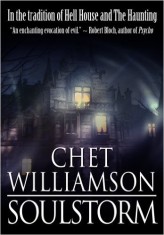

Dear Mr. Williamson,
Thanks for sharing your comments on your books and stories.
FWIW, this Lafcadio Hearn Reader really enjoyed your HOICHI book.
I’ve also scribbled even more notes on index cards about your other books to try to find at other libraries in the Los Angeles area, as well as on my Kindle.
Know that you’re busy, so no reply is necessary or expected.
Thanks again for lots of great reading over the years!
Sincerely,
Michael D. Toman
Dear Chet,
Don’t know when, if ever, you will check your website and read this comment, but just wanted to take an el quicko moment to let you know that it was great meeting you at this year’s Pulpfest.
I’m the guy who read your NOICHI book after finding it on the shelf at the Pasadena, CA public library. // Have you considered submitting any of your plays to any of the Usual Genre Suspects? Or publishing them for the benefit of your other long-time readers? // At the risk of fomenting more rejection and dejection for a fellow writer, will also ask if you’ve considered submitting anything to THE PARIS REVIEW? It would certainly be better than reading serialized novels already scheduled for publication by Farrar, Straus, & Giroux! // Yes, as a long-time subscriber, I did write to them to put in a good word for more original short fiction and less use of precious PR space for novels that don’t need any help finding readers. // “Answer came there none…” // While I would be delighted to hear from you someday, I’m still aware that “Free Time” is in short supply for everyone lately, much less writers, so no reply, immediate or otherwise, is necessary or expected. // “Keep Writing and I’ll Keep Reading!” // Sincerely, Michael D. Toman
Hi, Michael!
Great meeting you at PulpFest, and really enjoyed chatting with you. As far as publishing my plays goes, the thought’s occurred to me, but I’ve never approached a publisher about it. Fiction is hard enough to sell! Might be worth thinking more about, though. And I doubt I’ll be submitting to The Paris Review anytime soon — in another life, perhaps. Working on a play right now, a short one with somewhat horrific overtones, inspired by the recently deceased Shinobu Hashimoto’s screenplay for Kobayashi’s HARAKIRI.
And I suppose I’d better get back to it. Nice to hear from you, and hope to see you again!
Best,
Chet
Sir
I have read and truly enjoyed PSYCHO SANITARIUM.
Can i expect another Psycho novel from you.
Regards
Narayan
Trivandrum. India